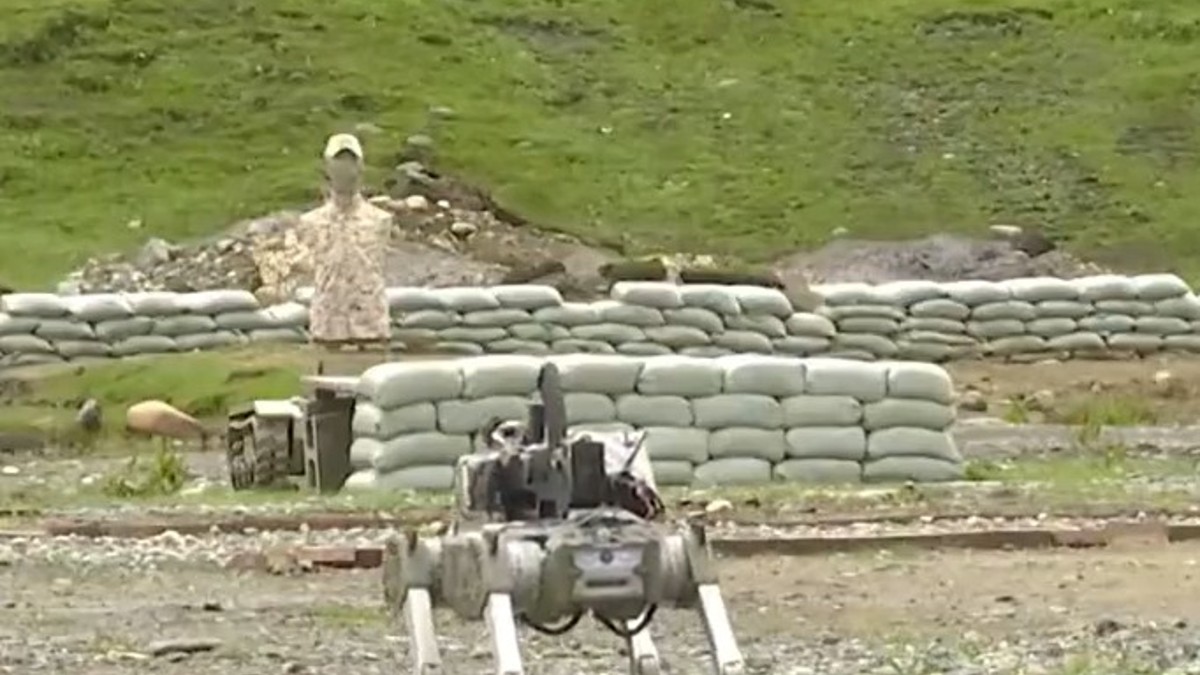The technology used in the military is advancing.
These days, utility robots are now mimicking dogs in both appearance and functionality.
Robotic dogs equipped with machine guns have been successfully tested by Chinese scientists, according to the South China Morning Post.
The accuracy of the small, four-legged robotic companions is quite close to that of skilled soldiers.
Traditionally used for entertainment purposes and to perform mundane tasks, these Chinese-made robotic canines are now repurposed for military purposes.
This could have a substantial impact on how conflict plays out in the future, particularly in urban combat situations.
Here’s all we know about them.
Putting guns on robotic dogs
A few videos of robotic dogs, designed to play a support role to humans, have been released by the Chinese military through official media in recent years.
Developed by a research team headed by Professor Xu Cheng of Nanjing University of Science and Technology, the videos demonstrate the strength and accuracy of these robotic canines.
The researchers have put a 7.62 millimetres machine gun on the robotic dogs, to achieve impressive precision with a half-dispersion radius of only five centimetres across a 100-metre range, the report said.
Impact Shorts
More Shorts🇨🇳At the exercises of the People's Liberation Army of China's reconnaissance units, robotic dogs made by the Chinese business China Kestrel Defence were equipped with QBZ-95 assault weapons. pic.twitter.com/sUuVqObh3X
— Aprajita Nafs Nefes 🦋 Ancient Believer (@aprajitanefes) July 13, 2023
Its accuracy exceeds that of the M16 rifle, which is known for being an accurate weapon, highlighting the technical strength that these quadruple platforms possess.
SCMP quoted lead scientist Xu Cheng and his colleagues as saying that the study “demonstrates the feasibility of a legged strike platform” in a peer-reviewed paper that was published in the Chinese Journal of Engineering last month.
Because of the rapid growth of China’s electronics industry, these developments have resulted in an enormous reduction in production costs, making this technology more widely available.
Influence on urban warfare
Researchers believe that this technology may have a big influence on how combat develops in the future.
“Urban warfare, encompassing anti-terrorism operations, hostage rescue missions, and the clearance of streets and buildings alike, has steadily risen to prominence as a fundamental facet of contemporary conflict,” Xu and his colleagues wrote in their paper.
“The urban landscape, with its maze of intersecting streets and towering edifices packed tightly together, poses unique challenges for unmanned combat platforms. These platforms must negotiate unstructured terrain and execute intricate actions such as manoeuvring, scaling, and leaping, rendering traditional wheeled and tracked designs inadequate.”
With a focus on bionic principles, these machines are highly adaptable and capable of navigating the difficult terrain of modern warfare.
“Quadruped platforms, based on bionic principles, can use independent ground support points to provide enhanced mobility and adaptability in complex urban combat environments,” the researchers said.
Similar attempts by the US
In 2021, a company named Ghost Robotics displayed the Q-UGV, a four-legged robot equipped with a Special Purpose Unmanned Rifle 4. The utility robots’ weaponisation was emphasised at the showcase event.
Another utility robot with four legs was used in a proof-of-concept test carried out by the US Marines in September 2023. Its capacity to “acquire and prosecute targets with the M72 Light Anti-Tank Weapon” was measured, according to The Conservation.
The American company Boston Dynamics developed the utility robot Spot, which resembles a dog. Another intriguing move was when the business released a video in November last year demonstrating how it had integrated the AI chatbot ChatGPT with its Spot robot.
One of the company’s engineers can be seen asking the machine questions and having conversations with it while utilising a variety of “personalities,” like an English butler. The AI chatbot provides the answers, but Spot mumbles them.
Ethical concerns
A new era in military technology has begun with the introduction of utility robots that are outfitted with rifles and have proven to be effective in engaging targets.
Although there is no denying the potential to improve combat capabilities and operational efficiency, the implications of these advancements must be carefully considered.
Concerns about ethics have arisen about the autonomy of robotic canines in making life-or-death judgements as their deployment into conflict becomes a serious possibility.
The international community has demanded strict laws to control the use of autonomous weaponry, including defence analysts and AI researchers.
As per The Conversation, dozens of the top robotics companies signed an open letter that was posted on Boston Dynamics’ website in 2022, expressing their opposition to the weaponisation of readily available commercial robots in the letter.
The firms did not, according to the letter, object “to existing technologies that nations and their government agencies use to defend themselves and uphold their laws.”
According to BNN Breaking, the US military’s execution of programmes like Project Maven and references to studies from the Centre for a New American Security and Public Citizen highlight the critical need for a strategic approach that gives ethical and human oversight top priority in the development and application of AI-driven warfare technologies.
With inputs from agencies


)

)
)
)
)
)
)
)
)



